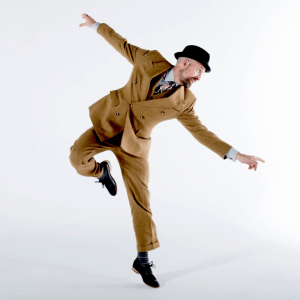Want to improve as a dancer, but don’t have a dance partner?
Do you feel like it’s challenging to work on your own dancing solo?
We get it, not everyone has a dance partner, and even if you do, it can be hard to find the time and space to practice together. But we have something important to tell you:
You don’t need a partner to improve. You’ve got yourself and there’s plenty to work on if you know where to look.
Not only can you train without a partner, but you should be training without a partner.
Every dancer should spend a considerable amount of time investing their personal practice, and the best part is, there’s no “correct way” to do it!
 Here are things you can do to improve your dancing when you can make time for yourself:
Here are things you can do to improve your dancing when you can make time for yourself:
So LOTS to talk about here. One of the important skills we’d like to focus on is how you can benefit from watching dance videos and/or lessons online and how you can use that to improve your dancing, even if you aren’t immediately getting the chance to try the material with a partner.
First, there’s something important to consider: Learning itself is a skill. Training your eyes and brain to absorb information through videos and lessons and retaining that information to relate it to your own body and movement is hugely beneficial. This doesn’t happen overnight, so let’s get to it! Here are some things to think about:
When you see a dancer you admire, try to break down what it is you like about them. Is it their style? What does that style come from exactly? Develop “eagle eyes” and a sharp brain to help you get into the details:
 Geography: Are they staying in place, or are they traveling?
Geography: Are they staying in place, or are they traveling?Get specific about what you’re seeing and really try to pinpoint the details so that you can try to recreate those details that you like.
Mimicry is actually a great way to learn. While you might start by completely copying a dancer you admire in order to understand the mechanics of how they move and approach the dance, you can’t stop there. The goal is to dance like you. You should use their style and technique in order to help you discover your own body and movement, which will help you develop your own style. Learn from others, but don’t let the information stop you from finding your own voice.
It works the same way when you take dance lessons. It’s not just about getting the moves—it’s also about becoming an overall, better dancer. Every individual move and lesson is a chance to both increase your repertoire but also to develop into a more masterful Lindy Hopper. When learning, you want to get into all the nitty-gritty details that will help you become better overall. That’s the real difference between an Intermediate and an Advanced dancer; the advanced dancer doesn’t just get the shape of a move but also learns to execute each move with their entire bodies and expert technique.
Investing to become a better learner will not only help you with online lessons, but will help you to get more out of classes and workshops that you attend in person too. In fact, watching and internalizing a lot of online lessons will prepare you to get the most out of your next dance camp because you’ll have been honing the skills that will enable you to milk those workshops for all that they’re worth. The more you learn, the better you get at learning, and the more you start to absorb into your brain and body, even when you aren’t physically dancing.
Spending time thinking about the dance when you’re not dancing will provide you with a plethora of ideas to take with you to the social dance floor. When you’re social dancing, you don’t want to overwhelm yourself by thinking about 20 things that you should be doing all at the same time. That’s way too much. BUT for every dance, it’s always great to have one or two ideas that you’re keeping in mind while you’re social dancing. Watching online lessons will give you a basis for these ideas that you can carry with you to the social floor.
Experienced Leaders tend to become really good at this kind of visual learning and they use it to “steal” new moves on the dance floor and make them their own. But you might argue that it’s an even more important skill for Followers because following is often a more subtle art form and really takes a keen eye and attention to detail to develop. The great thing about developing these learning skills as a Follower is that learning from watching can fill you with ideas that you can use no matter what level of partner you’re dancing with.
Every Lindy Hopper should have a solid foundation in solo jazz in their dance vocabulary. Jazz steps will help you develop your body movement, improve your rhythm, and will better help you understand the way that the dance connects with the music. They’ll also give you a creative basis for your Lindy Hop. Everyone should spend time alone working on solo jazz, body isolations, and general movement periodically and our online solo jazz lessons are a great way to do that. We cannot recommend enough the value of spending time in front of a mirror while getting to know your how your body moves.
 While some lessons are specifically focused on partner connection, there are many lessons that are absolutely perfect for solo development. These are resources that are at your disposal no matter where you are in the world, so why not take advantage of them? We can promise that with our own lessons, we’ve put a lot of care and love into them with the goal in mind of completely sharing everything we know for your benefit. They’re great for solo work.
While some lessons are specifically focused on partner connection, there are many lessons that are absolutely perfect for solo development. These are resources that are at your disposal no matter where you are in the world, so why not take advantage of them? We can promise that with our own lessons, we’ve put a lot of care and love into them with the goal in mind of completely sharing everything we know for your benefit. They’re great for solo work.
For example, in our Core Technique lessons, most of the lessons are ideal to work on without a partner. Footwork fundamentals, swivel technique for Followers, lazy fast footwork, and a variety of Charleston kick techniques (single, double, rotational) are only the beginning. Spinning and sliding exercises really take it to the next level.
There are also many Challenges you can approach on your own without a partner. We have a Leader’s swing out styling challenge, Followers swing out styling challenge, and challenges for Followers to create their own variations (Leader’s, you can use the same video as well. We recommend starting on your left foot :D).
As of January 2020, we’ve also added some helpful training videos the website to work on your solo movement. These 9 videos are all for solo training:
Have you ever put on some great swinging music and visualized how you would dance to it? This is an amazing exercise that both Leaders and Followers should try. The great thing about visualization is that in your mind, you can really imagine yourself dancing at your very best. When you’re dancing at your best, you probably won’t be dancing like a beginner. You’ll probably look a lot more like some of your favorite dance role models who you’ve watched on YouTube or in person, but with your own body dancing the way that those advanced dancers move. And guess what? That’s another amazing way to get to know the details of how your body works and moves. Imagine both the moves you would do at different times in the music to fit the musical phrase and also the styling and creativity you would add. The results can be magical!
Do you have other tips on how to work on your dancing on your own? We’d love to know about them! Leave us a comment to share your thoughts.
You must be logged in to post a comment.
Raesays:
Great article! Exactly the information I was looking for,, Thank you!
shaktisays:
thanks for sharing the information. I like your post it is very helpful.
Giorgia Mantosays:
Thanks, happy to read something I couldn’t explain and verbalise like you have done ❤️
Carol Cullensays:
Great article, I thought it was full of good advice. Thanks